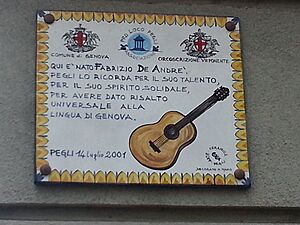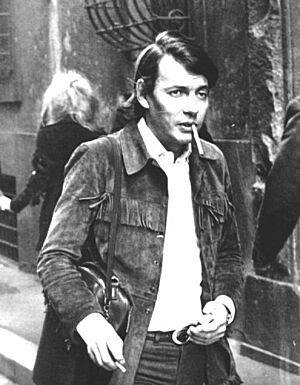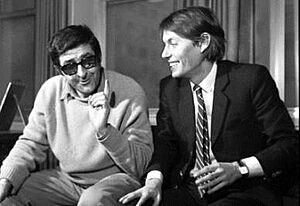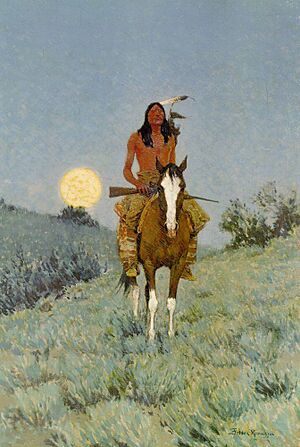Fabrizio De André facts for kids
Quick facts for kids
Fabrizio De André
|
|
|---|---|
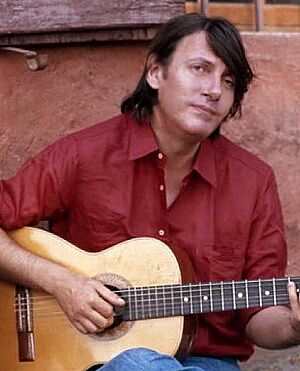
De André, c. 1977
|
|
| Background information | |
| Birth name | Fabrizio Cristiano De André |
| Born | 18 February 1940 Genoa, Kingdom of Italy |
| Died | 11 January 1999 (aged 58) Milan, Italy |
| Genres | |
| Occupation(s) | Singer-songwriter |
| Instruments |
|
| Years active | 1958–1999 |
| Labels |
|
Fabrizio Cristiano De André (born February 18, 1940 – died January 11, 1999) was a famous Italian singer and songwriter. He was known as a cantautore, which means a singer who writes their own songs. His career lasted 40 years, and he was interested in many things like poetry, books, and French music. He often created albums that told a story, called concept albums.
Fabrizio De André is considered a very important part of the "Genoese School" of music. His songs were so popular in Italy that many public places, like roads and schools, are named after him.
Contents
Biography
Fabrizio De André was born in Pegli, a part of Genoa, Italy. He came from a well-off family. He had a warm, deep singing voice and started playing the guitar when he was 14. His father gave him some records by a French singer named Georges Brassens. Brassens' songs greatly influenced Fabrizio's early music style. Brassens also inspired De André to believe in libertarian ideas (which means believing in freedom and limited government) and pacifism (which means believing in peace and opposing war). These ideas were very important in his music.
Early Career: The 1960s
In February 1961, while still a student, Fabrizio De André performed two songs for the first time in a theater in Genoa. These two songs, "Nuvole barocche" and "E fu la notte," became his first single later that year.
In his early recordings, De André developed his own unique style. He mixed ideas from literature with traditional songs, especially old Medieval ones. He became like a modern-day troubadour, a storyteller who sang about people often left out of society, like those who were poor or misunderstood. He also wrote "protest songs" that spoke out against unfairness. For example, he co-wrote La ballata del Miché ("Mickey's Ballad") and La Guerra di Piero ("Piero's War"), which was a famous anti-war song.
Some of his songs were inspired by his hometown, Genoa. These include La Città Vecchia ("The Old City") and Via del Campo. In 1963, he also wrote two songs with his friend Paolo Villaggio: Il Fannullone and Carlo Martello (ritorna dalla battaglia di Poitiers) ("Charles Martel Returns from the Battle of Poitiers").
In 1962, Fabrizio married Enrica "Puny" Rignon, and their first son, Cristiano De André, was born.
His song La canzone di Marinella ("The Song of Marinella") became his first big hit in 1967. This was thanks to a TV performance by the famous Italian singer Mina. Later, in 1984, American folk singer Joan Baez also sang "Marinella" on Italian television. After this success, De André released his first album of new songs, Volume 1, in 1967. The album starts with "Preghiera in Gennaio," a song dedicated to his friend, singer Luigi Tenco, who had passed away. Even though the Sanremo Festival was very popular, De André always refused to take part in any song competitions. He also rarely appeared on television. In 1966, his first collection of songs, Tutto Fabrizio De André, was released.
In 1968, De André released Tutti morimmo a stento, which was a "concept album." This means all the songs on the album were connected by a theme or story. It was also his first album to feature orchestral music. In 1969, he released Volume 3. Some of his songs from this album were censored by Italian TV because of their lyrics, but they were still played on Vatican Radio.
New Sounds: The 1970s
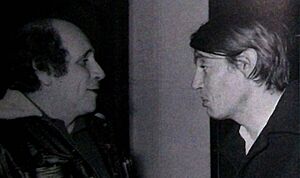
In 1970, the popular song Il pescatore ("The Fisherman") was released. That same year, he released another concept album called La buona novella. This album was inspired by the life of Jesus Christ, especially stories found in the Apocryphal gospels (which are ancient writings not included in the official Bible).
In 1971, he released Non al denaro non all'amore né al cielo. This album was inspired by the Spoon River Anthology, a book of poems by Edgar Lee Masters. The album's booklet even included an interview with Fernanda Pivano, who translated Master's book into Italian. In 1973, De André wrote Storia di un impiegato, a concept album about the social protests happening at that time.
His 1974 album, Canzoni, featured new versions of his older songs. It also included his translations of songs by famous artists like Georges Brassens, Leonard Cohen ("Suzanne" and "Joan of Arc"), and Bob Dylan ("Desolation Row"). In 1975, he worked with singer-songwriter Francesco De Gregori on the experimental album Volume/8.
Fabrizio De André performed his first live concert in 1975. Before this, he didn't like performing live, seeing himself more as a songwriter. Around this time, he moved from Genoa to Sardinia. In 1978, he released the album Rimini, which he wrote with Massimo Bubola. This album included his translation of Bob Dylan's "Romance in Durango." For the first time, he wrote a song in Gallurese, a local language spoken in Sardinia. This showed his growing interest in different languages and music traditions.
In 1977, his daughter Ludovica Vittoria (called Luvi) was born to his partner Dori Ghezzi. Between December 1978 and January 1979, De André went on tour with the Italian progressive rock band Premiata Forneria Marconi (PFM). Two live albums from this tour were released. Years later, in 2020, a video from this tour was found and released as a DVD.
On August 27, 1979, Fabrizio De André and Dori Ghezzi were kidnapped in Sardinia. They were released in December of that year.
Later Works: The 1980s and 1990s
In 1981, De André released the song Una storia sbagliata, which was about the writer Pier Paolo Pasolini. Later that year, he released an album without a title, often called L'Indiano (The Indian) because its cover showed a painting called The Outlier by Frederic Remington. This album had more of a rock music sound than his earlier works. The song Hotel Supramonte was inspired by his kidnapping experience. In 1982, De André, who didn't like traveling much, went on his first and only European tour, visiting Austria, Germany, and Switzerland.
In 1984, he released the album Crêuza de mä, which he made with Mauro Pagani. This album was very unique because its music was inspired by Mediterranean sounds and used instruments from many different local traditions. It was entirely sung in Genoese, the language of Genoa. David Byrne, a famous musician, later called this album one of the most important releases of the decade.
In 1989, Fabrizio De André married Dori Ghezzi. His long-time friend, the actor Beppe Grillo, was a witness at their wedding. Sadly, Fabrizio's brother Mauro passed away in the same year.
In 1990, De André released Le nuvole, another collaboration with Mauro Pagani. The first half of the album was sung in Italian, while the second half featured songs in Sardinian, Genoese, and Neapolitan languages. In 1991, he went on tour and released a double live album called 1991 Concerti.
De André also worked with other artists during these years. He sang with Ricky Gianco on "Navigare" (1992) and with Max Mandredi on "La Fiera della Maddalena" (1994). He also collaborated with the band Tazenda, singing a song in Sardinian and co-writing "Pitzinnos in sa gherra" ("Children in the War"). In 1995, he sang in an old Occitan language with the band Troubaires de Coumboscuro.
In 1996, he released his last album, Anime Salve, which was a concept album about feeling alone. He worked on this album with Ivano Fossati. The first song on the album, "Prinçesa," was inspired by the life story of a transsexual person named Fernanda Farias De Albuquerque. This song won an award called the Targa Tenco. The last song, "Smisurata preghiera," was inspired by the writer Álvaro Mutis and also won an award.
Also in 1996, De André co-wrote his only novel, Un destino ridicolo ("A Ridiculous Destiny"), with writer Alessandro Gennari. This novel later inspired a film in 2008. In 1997, he recorded a new version of "Marinella," this time as a duet with Mina.
From 1997 to 1998, De André went on the longest tour of his career, performing in large venues and theaters. This long tour had to be stopped because he started having health problems. He was then diagnosed with lung cancer.
Fabrizio De André passed away in Milan on January 11, 1999. Two days later, a large public funeral was held in Genoa. He was buried in his family's chapel in the Monumental Cemetery of Staglieno.
Discography
Albums
- Volume 1 (1967)
- Tutti morimmo a stento (1968)
- Volume 3 (1968)
- La buona novella (1970)
- Non al denaro non all'amore né al cielo (1971)
- Storia di un impiegato (1973)
- Canzoni (1974)
- Volume 8 (1975)
- Rimini (1978)
- Fabrizio De André (1981)
- Crêuza de mä (1984)
- Le nuvole (1990)
- Anime salve (1996)
Live Albums
- Fabrizio De André in Concerto (1979)
- Fabrizio De André in Concerto vol. 2 (1980)
- 1991 concerti (1991)
- In concerto (1999)
- Ed avevamo gli occhi troppo belli (2001)
Videography
Concerts
- Fabrizio De André in Concerto (2004)
- Fabrizio De André e PFM - Il concerto ritrovato (2020)
Documentaries
- Effedia: Sulla mia cattiva strada (2008)
- Dentro Faber (2011)
- Faber in Sardegna & L'ultimo concerto di Fabrizio De André (2015)
Movies Inspired by De André
- Amore che vieni, amore che vai (2008)
- Fabrizio De André - Principe libero (2018)
Images for kids
-
De André with Leo Ferré, 1975
See also
 In Spanish: Fabrizio De André para niños
In Spanish: Fabrizio De André para niños


